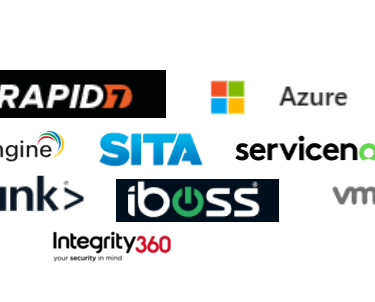Portfolio Program and Projects
In addition to my primary responsibilities, I have assumed the role of a portfolio manager, supervising three distinct programs that encompass a total of twenty-eight simultaneous projects. My experience also extends to serving as the program manager over seeing eight significant projects simultaneous, and I have frequently been entrusted with the position of senior project manager for numerous critical initiatives.
List of some of the vendors, suppliers and consultants I have worked with to deliver Projects, Programs and Portfolios


Case Study Zero Trust
Introduction: As an experienced practitioner in the realm of cybersecurity, I've overseen the implementation of Zero Trust Network Access (ZTNA) for various clients. In this case study, I'll delve into the challenges encountered, successful strategies employed, and areas for improvement, drawing valuable lessons from the experience.
Understanding Zero Trust and Secure Access Service Edge (SASE): Zero Trust Network Access (ZTNA) revolutionises security paradigms by necessitating authentication prior to access, mitigating risks associated with unauthorised network entry. This approach is vital in today's dynamic work landscape, characterised by remote operations and heightened cybersecurity threats. Secure Access Service Edge (SASE) complements ZTNA, amalgamating WAN and security services to fortify network defenses within a cloud-centric infrastructure. By incorporating ZTNA alongside Cloud Secure Web Gateway (SWG) and Firewall as a Service (FWaaS), SASE optimizes security posture while bolstering organisational agility.
Project Scope and Objectives: The project aimed to deploy Zero Trust agents across all endpoints, implement Multifactor Authentication (MFA), and establish access policies based on user groups for IaaS and SaaS applications. Additionally, configuring firewalls and conducting thorough testing in non-production environments were crucial steps before transitioning to the production phase. The overarching goal was to restrict access to applications and services solely through the Zero Trust solution, enhancing security measures organisation wide.
Challenges Encountered:
Resistance to Adoption: Despite the evident security enhancements, resistance from certain user segments, notably developers and business managers, posed a significant hurdle. Misconceptions regarding intrusive monitoring and perceived constraints on workflow hindered widespread acceptance of the ZTNA solution. The consumption-oriented deployment approach initially failed to resonate with users, exacerbating adoption challenges.
GDPR Compliance Concerns: Processing information in the cloud raised legitimate concerns regarding compliance with GDPR regulations, particularly concerning the transfer of personally identifiable information (PII) outside the EU jurisdiction. Addressing these compliance issues demanded meticulous attention to data governance protocols and robust encryption mechanisms. Vendor implementing a ZTNA cloud within the EU address a lot of concerns.
Identity Access Management Complexity: Managing access to a myriad of applications and transient virtual machines (VMs) proved challenging, necessitating streamlined identity access management (IAM) protocols. The dynamic nature of cloud-based infrastructures accentuated the complexity of IAM, requiring agile solutions to ensure seamless user access without compromising security.
Policy Management for Scale: Crafting and enforcing access policies for thousands of users posed scalability challenges. Maintaining granular control over access permissions while accommodating evolving user roles and privileges demanded a scalable policy management framework.
Approach and Strategies:
Consumption-oriented approach: Early success with pilot groups and early adopters went well but failed to yield the desire response of getting all the users to willing adopt the technology.
Escalation to Senior Management: Escalating the issue to senior management, however, proved instrumental in catalysing organisational support. Despite initial reluctance, senior leaders recognised the imperative of ZTNA adoption and actively championed its implementation.
Introducing Urgency: Recognising the need for a change in thinking in user mindset, a decisive step was taken to introduce urgency into the adoption process. A set date for legacy proxy shutdown, accompanied by the prospect of internet connectivity loss for non-compliant users, galvanised senior management into action. The mandate to ensure uninterrupted business operations served as a catalyst for driving user adoption of ZTNA.
Lessons Learned and Recommendations:
Realistic Timeframe Estimation: Underestimating the complexities inherent in Zero Trust implementations led to project delays. Future initiatives should incorporate buffer timelines to accommodate unforeseen challenges and ensure realistic project timelines.
Stakeholder Engagement and Communication: Proactive stakeholder engagement and transparent communication are paramount to overcoming resistance and fostering organisational alignment. Regular updates, feedback mechanisms, and tailored communications to different stakeholder groups enhance project transparency and mitigate apprehensions.
Continuous Evaluation and Adaptation: The dynamic nature of cybersecurity mandates continuous evaluation and adaptation of security frameworks. Regular audits, threat assessments, and performance evaluations facilitate proactive risk mitigation and ensure the efficacy of security measures in safeguarding organisational asset.
Key Takeaway:
Resistance to Change: It is imperative not to underestimate the innate human tendency to resist change. While initial success may be achieved with early adopters, overcoming resistance from the majority within the constraints of project schedules and timelines can prove challenging.
Senior Management Support: In organisations with robust senior management support, user resistance can be mitigated by prioritising ZTNA as a critical business initiative. Swift decision-making at the management level to expedite the rollout of ZTNA significantly reduces barriers to adoption and fosters a culture of proactive security readiness.
Case Study Overcoming Bottlenecks in Project Teams
Introduction: In the realm of project management, teams often encounter challenges that impede progress and hinder overall efficiency. One such challenge arises when a team member, despite their exceptional skills and contributions, inadvertently becomes a bottleneck, slowing down the project's pace and creating dependencies. In this case study, we explore the impact of bottlenecks on project teams and discuss strategies for resolving this issue both in the short term and the long term.
Identifying the Bottleneck: In our project, the development of a new software application was progressing smoothly until we noticed a recurring pattern: all major decisions and tasks seemed to bottleneck at one particular team member, (not real name) Sarah. As the lead developer, Sarah possessed unparalleled technical expertise and problem-solving skills. However, her central role in the project inadvertently created dependencies, causing delays in decision-making and task execution.
Short-Term Solutions:
Task Redistribution: To alleviate immediate bottlenecks, we redistributed tasks and responsibilities among team members. By empowering other developers to take on additional responsibilities and make autonomous decisions within their areas of expertise, we reduced the dependency on Sarah and distributed the workload more evenly.
Parallel Task Execution: Instead of waiting for Sarah's approval at every stage, we encouraged parallel task execution wherever possible. By breaking down larger tasks into smaller, more manageable subtasks and allowing team members to work concurrently on different aspects of the project, we minimised downtime and accelerated progress.
Regular Communication: Transparent and open communication became paramount in mitigating bottlenecks. Regular team meetings were scheduled to discuss project updates, identify potential roadblocks, and solicit input from all team members. This facilitated a collaborative environment where concerns could be addressed promptly, and decisions could be made collectively.
Long-Term Solutions:
Skill Development and Cross-Training: Recognising the risks associated with over-reliance on individual team members, we prioritised skill development and cross-training initiatives. By investing in the professional growth of team members and fostering a culture of knowledge sharing, we aimed to build a more resilient and versatile team capable of handling diverse challenges without depending solely on one individual.
Process Optimisation: We undertook a comprehensive review of our project processes and workflows to identify areas for optimisation and streamlining. By implementing agile methodologies and leveraging project management tools, we aimed to create more efficient processes that minimised dependencies and facilitated smoother collaboration among team members.
Succession Planning: Acknowledging the possibility of team member turnover or unforeseen circumstances, we developed a robust succession plan to ensure continuity and resilience within the team. This involved documenting critical knowledge and processes, identifying potential successors, and providing them with the necessary training and support to seamlessly transition into key roles if needed.
Key Takeaways:
Bottlenecks can arise even from the most skilled team members and must be addressed promptly to prevent project delays.
Short-term solutions such as task redistribution and parallel task execution can alleviate immediate bottlenecks.
Long-term strategies such as skill development, process optimisation, and succession planning are essential for building a resilient and adaptable team.
Project Portfolio
IT Infrastructure Management:
Guided large-scale infrastructure projects from inception to successful execution, ensuring seamless operations and optimal resource utilisation.
Enterprise Networking Solutions:
Led the strategic planning, implementation, and optimisation of enterprise-grade networking solutions, enhancing connectivity, and driving business efficiency.
End-to-End Systems Integration:
Managed comprehensive system integration projects, orchestrating the seamless integration of software, hardware, and internal/external systems to deliver robust solutions aligned with organisational goals.
Custom Application Development:
Directed the development and deployment of tailored applications to meet specific organisational requirements, driving innovation and enhancing operational effectiveness.
Large-Scale System Integration:
Spearheaded complex system integration initiatives across diverse platforms and technologies, ensuring interoperability and scalability at enterprise levels.
Cybersecurity Implementation:
Implemented stringent cybersecurity measures based on the NIST Cybersecurity Framework, safeguarding organisational assets and mitigating risks effectively.
Regulatory Compliance Management:
Ensured adherence to regulatory standards and company policies, collaborating with regulatory bodies and auditors to maintain compliance and mitigate risks.
Transformational Projects:
Orchestrated transformative initiatives to drive organisational change, streamline processes, and achieve strategic objectives, fostering growth and sustainability.
Change Management Leadership:
Led change management efforts to facilitate smooth transitions, minimise resistance, and maximise stakeholder engagement during project implementations, ensuring successful outcomes.
Some of the companies I have managed projects, programs, and portfolios for.




Contact
info@tomshine.net
© Tomshine.net 2024
